NCERT Solutions | Class 11 Chemistry Chapter 4 | Chemical Bonding and Molecular Structure

CBSE Solutions | Chemistry Class 11
Check the below NCERT Solutions for Class 11 Chemistry Chapter 4 Chemical Bonding and Molecular Structure Pdf free download. NCERT Solutions Class 11 Chemistry were prepared based on the latest exam pattern. We have Provided Chemical Bonding and Molecular Structure Class 11 Chemistry NCERT Solutions to help students understand the concept very well.
NCERT | Class 11 Chemistry
| Book: | National Council of Educational Research and Training (NCERT) |
|---|---|
| Board: | Central Board of Secondary Education (CBSE) |
| Class: | 11th |
| Subject: | Chemistry |
| Chapter: | 4 |
| Chapters Name: | Chemical Bonding and Molecular Structure |
| Medium: | English |
Chemical Bonding and Molecular Structure | Class 11 Chemistry | NCERT Books Solutions
NCERT Exercises
NCERT Solutions for Class 11 Chemistry Chapter 4, Question 1.
Solution.
The attractive force which holds various constituents (atoms, ions, etc.) together in different chemical species is called a chemical bond. The formation of chemical compounds takes place as a result of combination of atoms in different ways. The atoms interact with each other on account of following reasons :(i) Lowering of energy of combining atoms : The process of bonding between the atoms decreases the energy of the combining atoms and gives rise to the formation of a system which has lower energy and hence has greater stability.
(ii) Lewis octet rule : Octet theory of valency or electronic theory of valency states that in the formation of a chemical bond, atoms interact with each other by losing, gaining or sharing of electrons so as to acquire a stable outer shell of eight electrons. The tendency of atoms to achieve eight electrons in their outermost shell is known as Lewis octet rule.
NCERT Solutions for Class 11 Chemistry Chapter 4, Question 2.
Mg, Na, B, O, N, Br.
Solution.
Lewis dot symbols :
NCERT Solutions for Class 11 Chemistry Chapter 4, Question 3.
S and S2-; Al and Al3+; H and H–
Solution.
Lewis symbols:
NCERT Solutions for Class 11 Chemistry Chapter 4, Question 4.
H2S, SiCl4, BeF2, \({ CO }_{ 3 }^{ 2- }\), HCOOH.
Solution.
Lewis structures :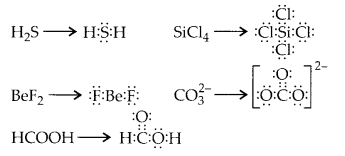
NCERT Solutions for Class 11 Chemistry Chapter 4, Question 5.
Solution.
Octet rule : The tendency of atoms in molecules to have eight electrons in their valence shells (two for hydrogen atom) is known as the octet rule.Significance :
- It explains the formation of most of the compounds.
- It is quite useful for understanding the structures of most of the organic compounds.
Limitations:
- In some compounds, the number of electrons surrounding the central atom is less than eight e.g., LiCl, BeH2 and BCl3.
- In molecules with an odd number of electron like nitric oxide (NO) and nitrogen dioxide (NO2), the octet rule is not satisfied for all the atoms.

- In a number of compounds there are more than eight valence electrons around the central atom. This is termed as the expanded octet. Some of the examples of such compounds are PF5, SF6, H2SO4 and a number of coordination compounds.
NCERT Solutions for Class 11 Chemistry Chapter 4, Question 6.
Solution.
The following factors facilitate the formation of an ionic bond between a metal and a non-metal:- Ionization energy : Lesser the ionization energy, greater is the ease of formation of a cation.
- Electron affinity : High electron affinity favours formation of an anion.
- Lattice Energy : It is defined as the amount of energy released when cations and anions are brought close to each other from infinity to their respective equilibrium sites in the crystal lattice to form one mole of the ionic compound. The higher the magnitude of the lattice energy, the greater is the tendency of the formation of an ionic bond.
NCERT Solutions for Class 11 Chemistry Chapter 4, Question 7.
Solution.
According to VSEPR theory, the shape of molecule depends upon the number of valence shell electron pairs (bonded or non bonded) around the central atom.(i) BeCl2: Presence of two bond pairs and lack of lone pairs gives it linear shape. Cl: Be : Cl
(ii) BCl3 : Presence of three bond pairs and lack of lone pairs gives it trigonal planar geometry.

(iii) SiCl4 : Presence of four bond pairs and lack of lone pairs gives it tetrahedral geometry.
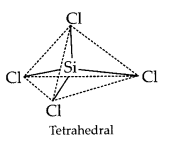
(iv) AsF5 : Presence of five bond pairs and lack of lone pairs gives it trigonal bipyramidal geometry.
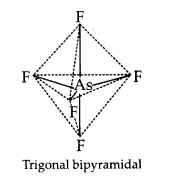
(v) H2S : Presence of two bond pairs and two lone pairs gives it angular or bent shape.

(vi) PH3 : Presence of three bond pairs and one lone pair gives it trigonal pyramidal shape.

NCERT Solutions for Class 11 Chemistry Chapter 4, Question 8.
Solution.
Bond angle in NH3 is 107.5° and in H2O, angle is 104.5°. In H2O, oxygen has two lone pairs and in NH3, nitrogen has only one lone pair. In H2O, two lone pairs on oxygen repel each other and the bonded pairs more strongly and cause them to come closer thereby reducing the angle.NCERT Solutions for Class 11 Chemistry Chapter 4, Question 9.
Solution.
Greater the bond order, shorter is the bond length and so, higher is the bond strength.NCERT Solutions for Class 11 Chemistry Chapter 4, Question 10.
Solution.
The equilibrium distance between the centres of the nuclei of two atoms bonded together is termed as bond length or bond distance.Bond length in ionic compounds = \({ r }_{ c }^{ + }+{ r }_{ a }^{ – }\)
Bond length in covalent compounds (AB) = rA+ rB
NCERT Solutions for Class 11 Chemistry Chapter 4, Question 11.
Solution.
Whenever a single Lewis structure cannot describe a molecule accurately, a number of structures with similar energy, positions of nuclei, bonding and non-bonding pairs of electrons, known as the canonical forms of the hybrid are taken, which describe the molecule accurately. This phenomenon is known as resonance.Resonance hybrid structures of carbonate ion are shown as follows :

- The relative position of all the atoms in each of the canonical forms is same.
- The number of unpaired and paired electrons in each of the canonical forms is same.
- Negative charge is residing on more electronegative atom.
- As a result of resonance, bond length and bond order is same.
NCERT Solutions for Class 11 Chemistry Chapter 4, Question 12.

Solution.
These two cannot be called as canonical forms as relative position of hydrogen is changed. In resonance, canonical forms should differ only in the position of electrons and not in the position of atoms.NCERT Solutions for Class 11 Chemistry Chapter 4, Question 13.
Solution.
SO3
NO2
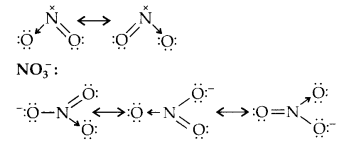
NCERT Solutions for Class 11 Chemistry Chapter 4, Question 14.
(a) K and S
(b) Ca and O
(c) Al and N.
Solution.
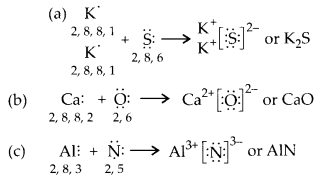
NCERT Solutions for Class 11 Chemistry Chapter 4, Question 15.
Solution.
Even though both CO2 and H2O are triatomic, but CO2, has zero dipole moment. It implies that CO, has a symmetrical structure which is possible only when it is linear. However, H20 has a net dipole moment suggesting that the molecule is non-linear.
NCERT Solutions for Class 11 Chemistry Chapter 4, Question 16.
Solution.
Applications of dipole moment are :- To decide polarity of the molecule : Molecules having zero dipole moment are said to be non-polar molecules and those having µR ≠ 0 are polar in nature.
- To determine percentage of ionic character :
Percentage of ionic character
\(=\frac { Experimental\quad value\quad of\quad dipole\quad moment }{ Theoretical\quad value\quad of\quad dipole\quad moment } \times 100\) - To determine geometry of molecules: The values of dipole moments provide valuable information about the structures of molecules.
- CO2, CS2 are linear as values of their dipole moments are zero.
- H2O is non-linear as it has a net dipole moment.
NCERT Solutions for Class 11 Chemistry Chapter 4, Question 17.
Solution.
The relative tendency of a bonded atom to attract the shared electron pair towards itself is called electronegativity while electron gain enthalpy is the energy change that occurs for the process of adding an electron to a gaseous isolated atom to convert it into a negative ion i.e., to form, a monovalent anion. Electron gain enthalpy and electronegativity both measure the power of attracting electrons, but electron gain enthalpy is concerned with an isolated gaseous atom while electronegativity is concerned with the atom in combination.NCERT Solutions for Class 11 Chemistry Chapter 4, Question 18.
Solution.
In a hetero-atomic molecule the shared pair of electrons between the two atoms gets displaced more towards the electronegative atom. The resultant covalent bond is polar covalent bond e.g., in H – F the electron pair is displaced towards fluorine due to highly electronegative F atom. Hence H develops a partial +ve charge while F develops a partial-ve charge \(\overset { \delta + }{ H } -\overset { \delta – }{ F } \).
NCERT Solutions for Class 11 Chemistry Chapter 4, Question 19.
Solution.
As per Fajan’s rule, N2 < SO2 < CIF2 < K2O < LiFNCERT Solutions for Class 11 Chemistry Chapter 4, Question 20.

Solution.
In the given figure, hydrogen has valency of two, which is not possible and also octet of oxygen is not complete.So, the correct structure is

NCERT Solutions for Class 11 Chemistry Chapter 4, Question 21.
Solution.
In CH4 only bond pairs are there and no lone pairs are present so, to attain most stabilized structure it arranges itself in tetrahedral geometry with greater bond angle of 109° rather than in square planar geometry with lesser bond angle of 90°.NCERT Solutions for Class 11 Chemistry Chapter 4, Question 22.
Solution.
The dipole moment in case of BeH2 is zero. This is because the two equal bond dipoles point in opposite directions and cancel the effect of each other.
NCERT Solutions for Class 11 Chemistry Chapter 4, Question 23.
Solution.
Both the molecules NH3 and NF3 have pyramidal shape with a lone pair of electron on nitrogen atom. Although fluorine is more electronegative than nitrogen, the resultant dipole moment of NH3 (4.90 x 10-30 C m) is greater than that of NF3 (0.8 x 10<sup.-30C m). This is because, in case of NH3 the orbital dipole due to lone pair is in the same direction as the resultant dipole moment of the N—H bonds whereas in NF3 the orbital dipole is in the direction opposite to the resultant dipole moment of the three N—F bonds. The orbital dipole because of lone pair decreases the effect of the resultant N—F bond moment which results in low dipole moment of NF3 as represented below :
NCERT Solutions for Class 11 Chemistry Chapter 4, Question 24.
Solution.
Hybridisation can be defined as the process of intermixing of the orbitals of slightly different energies so as to redistribute their energies, resulting in the formation of new set of orbitals of equivalent energies and shape.Salient features of hybridisation : The main features of hybridisation are as under :
- The number of hybrid orbitals is equal to the number of the atomic orbitals that undergo hybridisation.
- The hybrid orbitals are always equivalent in energy and shape.
- The hybrid orbitals are more effective in forming stable bonds than the pure atomic orbitals.
- These hybrid orbitals are directed in space in some preferred directions to have minimum repulsion between electron pairs and thus have a stable arrangement. Therefore, the type of hybridisation indicates the geometry of the molecules.
Important conditions for hybridisation :
- Only those orbitals that are present in the valence shell of the atom undergo hybridisation.
- The orbitals undergoing hybridisation should have almost equal energy.
- Promotion of electron is not essential condition prior to hybridisation.
- It is not necessary that only half filled orbitals participate in hybridisation. In some cases, even filled orbitals of valence shell take part in hybridisation.
Shapes of hybrid orbitals :
(i) sp-hybridisation : One ‘s’ and one ‘p’ orbital of an atom intermix giving two sp-hybrid orbitals making an angle of 180° with each other. Each hybrid orbital has 50% s and 50% p-orbital character.
The molecules having such type of hybridisation in their central atom have linear geometry with bond angles 180°. Examples : BeCl2, C2H2, CO2, HgCl2, CS2, N2O, BeH2, etc.
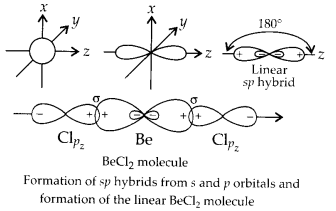
(ii) sp2-hybridisation : One ‘s’ and two ‘p’ orbitals of an atom intermix giving three sp2-hybrid orbitals, which are directed towards the corners of an equilateral triangle making an angle of 120° with each other. Each hybrid orbital has 33.3% s and 66.7% p-orbital character. The molecules having such type of hybridisation in their central atom are expected to have triangular planar geometry with bond angles 120°.
Examples : BCl3, BF3, SO3, C2H4, Graphite, SO2, etc.
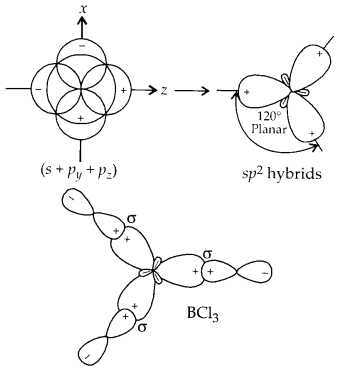
(iii) sp2-hybridisation : One ‘s’ and three ‘p’ orbitals of an atom intermix giving four sp2-hybrid orbitals, which are directed towards the corners of a regular tetrahedron making an angle of 109°28′. Each hybrid orbital has 25% s- and 75% p-orbital character. The molecules having such type of hybridisation in their central atom are expected to have tetrahedral geometry with bond angles 109°28′.
Examples : CH4, C2H6, CCl4, H2O, NH3, diamond, etc.
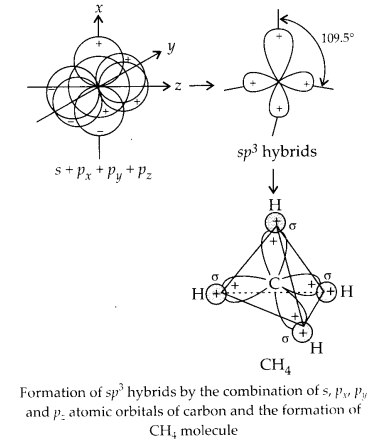
NCERT Solutions for Class 11 Chemistry Chapter 4, Question 25.
Alcl3 + cl– → \({ AlCl }_{ 4 }^{ – }\)
Solution.
There is change in hybridization from sp2 → sp3. In AlCl3, Al is sp2 hybridised. AlCl3 thus has three sp2 hybrid orbitals and a vacant unhybrid p-orbital. When \({ AlCl }_{ 4 }^{ – }\) is formed, Al undergoes sp3 hybridisation and thus Cl– overlaps with the fourth orbital.NCERT Solutions for Class 11 Chemistry Chapter 4, Question 26.
Solution.
In BF3, B is sp2 hybridised and has one vacant p-orbital which gets filled by accepting a lone pair of electron present on the N-atom of NH3. Nitrogen in this adduct acts as donor atom and BF3 acts as an acceptor. So, hybridization of B in BF3 changes from sp2 to sp3 whereas there is no change in hybridization of N in NH3 and in the adduct.NCERT Solutions for Class 11 Chemistry Chapter 4, Question 27.
Solution.
C2H4 molecule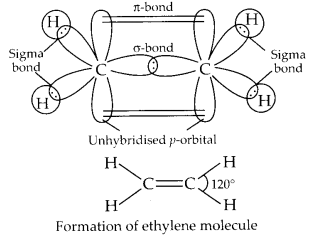
C2H2 molecule
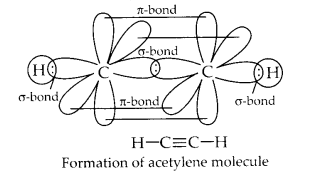
NCERT Solutions for Class 11 Chemistry Chapter 4, Question 28.
(a) C2H2
(b) C2H4
Solution.
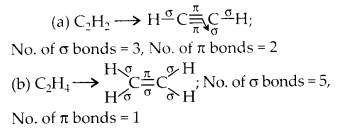
NCERT Solutions for Class 11 Chemistry Chapter 4, Question 29.
(a) 1s and 1s
(b) 1s and 2px
(c) 2py and 2py
(d) 1s and 2s
Solution.
A bond formed between two atoms by the overlap of singly occupied orbitals along their axes (end to end overlap) is called c bond. Hence, 1s and 1s, 1s and 2px and 1s and 2s will form σ bonds. π bonds are formed by the sidewise or lateral overlapping of p-orbitals. Hence, pyand py orbitals will form π bond.NCERT Solutions for Class 11 Chemistry Chapter 4, Question 30.
(a) CH3CH3
(b) CH3CH = CH2
(c) CH3CH2OH
(d) CH3CHO
(e) CH3COOH
Solution.
(a) sp3, sp3(b) sp3, sp2, sp2
(c) sp3, sp3
(d) sp3, sp2
(e) sp3, sp2
NCERT Solutions for Class 11 Chemistry Chapter 4, Question 31.
Solution.
Bond pairs are the pairs of electrons taking part in bonding e.g.,A pair of electrons in a molecule which is not shared by any of the two constituent atoms i.e., does not take part in the direct bonding is called a lone pair e.g.,

NCERT Solutions for Class 11 Chemistry Chapter 4, Question 32.
Solution.
Comparison between σ and π bonds| Sigma bond | Pi bond | |
| 1. | The bond is formed by the overlap of orbitals along their axes (end to end overlap). It includes s-s and p-p overlapping. |
The bond is formed by sidewise overlapping of orbitals (lateral overlapping). It includes p-p overlapping. |
| 2. | It is a strong bond. | It is a weak bond. |
|
3. |
There can be free rotation of atoms around this bond. | Free rotation is not possible around this bond. |
| 4. | The shape of the molecule is determined by these bonds. | These bonds do not affect the shape of the molecule. |
| 5. | o-electrons are referred to as localized electrons. | 71-electrons are referred to as mobile electrons. |
NCERT Solutions for Class 11 Chemistry Chapter 4, Question 33.
Solution.
We can consider two hydrogen atoms A and B approaching each other having nuclei NA and NA and electrons present in them are represented by eA and eA. When the two atoms are at large distance from each other, there is no interaction between them. As these two atoms begin to approach each other, new attractive and repulsive forces begin to operate.Attractive forces arise between :
- nucleus of one atom and its own electron that is NA – eA and NB – eB.
- nucleus of one atom and electron of other atom i.e., NA – eB, NB – eA.
Similarly repulsive forces arise between :
- electrons of two atoms like eA – eB.
- nuclei of two atoms NA – NB.
Attractive forces tend to bring the two atoms close to each other whereas repulsive forces tend to push them apart.
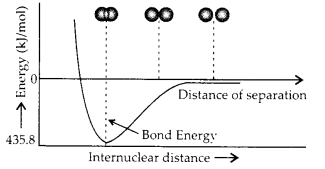
- Experimentally it has been found that the magnitude of new attractive forces is more than the new repulsive forces. As a result, two atoms approach each other and potential energy decreases. Ultimatelv a stage is reached where the net force of attraction balances the force of repulsion and system acquires minimum energy. At this stage two hydrogen atoms are said to be bonded together to form a stable molecule having the bond length of 74 pm.
Since the energy gets released when the bond is formed between two hydrogen atoms, the hydrogen molecule is more stable than isolated hydrogen atoms. The energy so released is caljed bond enthalpy, which corresponds to the minimum in the curve depicted in fig. Conversely, 435.8 kj of energy is required to dissociate one mole of H2 molecule.
H2(g) + 435.8 kj mol-1 → H(g) + H(g)
NCERT Solutions for Class 11 Chemistry Chapter 4, Question 34.
form molecular orbitals.
Solution.
Necessary conditions for linear combination of atomic orbitals :- The symmetry and relative energies of combining atomic orbitals A and B must be close to each other.
- The extent of overlap between the charge clouds of A and B should be large,
- Atomic orbitals of the same sign should overlap.
NCERT Solutions for Class 11 Chemistry Chapter 4, Question 35.
Solution.
Beryllium atom has electronic configuration 1s2 2s2. So, in Be2 there are a total of eight electrons which must be filled in four molecular orbitals.M.O. configuration of Be2 → σ1s2σ*1s2 σ2s2 σ*2s2
B.O. = 1/2(4 – 4) = 0. Since the bond order is zero it shows that molecular beryllium will not exist.
NCERT Solutions for Class 11 Chemistry Chapter 4, Question 36.
Solution.
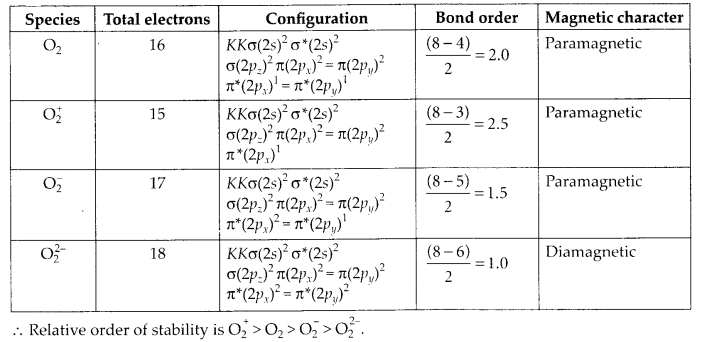
NCERT Solutions for Class 11 Chemistry Chapter 4, Question 37.
Solution.
The plus ancj minus sign indicate the sign of the wave function in the various lobes and not that of the nuclear or electronic charges. The ‘+’ sign (or upward crest) represents one phase and thesign represents second phase of the wave function. Bonding molecular orbital is formed by combination of ‘+’ with ‘+’ and with part of the electron waves whereas antibonding molecular orbital is formed by combination of ‘+’ with part of the electron waves.As orbitals are represented by wave functions, a plus sign in an orbital represents a +ve wave function and a minus sign represents a -ve wave function.
NCERT Solutions for Class 11 Chemistry Chapter 4, Question 38.
Solution.
Formation of PCl5 (sp3d hybridisation):The ground state and the excited state outer electronic configurations of phosphorus (Z = 15) are represented here.
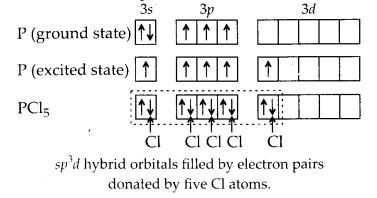
Now the five orbitals (i.e., one s, three p and one d orbital) are available for hybridisation to yield a set of five sp3d hybrid orbitals which are directed towards the five corners of a trigonal bipyramid as depicted in the figure.
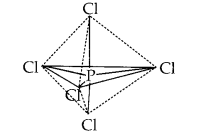
All the bond angles in trigonal bipyramidal geometry are not equivalent. In PCl5 the five sp3d orbitals of phosphorus overlap with the singly occupied p orbitals of chlorine atoms to form five P-Cl sigma bonds. Three P-Cl bonds lie in one plane and make angle of 120° with each other; these bonds are termed as equatorial bonds. The remaining two P-Cl bonds, one lying above and the other lying below the equatorial plane, make an angle of 90° with the plane. These bonds are called axial bonds. As the axial bond pairs suffer more repulsive interaction from the equatorial bond pairs, therefore axial bonds have been found to be slightly longer and hence slightly weaker than the equatorial bonds.
NCERT Solutions for Class 11 Chemistry Chapter 4, Question 39.
Solution.
Hydrogen bond can be defined as an attractive force which binds hydrogen atom of one molecule with the electronegative atom (F, O or N) of another molecule. Following conditions should be fulfilled by a molecule for the formation of hydrogen bond.(a) Hydrogen atom should be linked to a highly electronegative atom, such as F, O or N through a covalent bond.
(b) The size of the electronegative atom bonded covalently to the hydrogen atom should be small.
Types of H-bonding:
Intermolecular hydrogen bond : When hydrogen bond is formed between the hydrogen atom of one molecule and the electronegative atom of another molecule of the same compound (such as HF) or different compounds (such as water and alcohol), it is known as intermolecular hydrogen bond.
>

Intermolecular Hydrogen bond : When hydrogen bond is formed between the hydrogen atom and an electronegative atom, present in the same molecule, it is known as intramolecular hydrogen
bond.
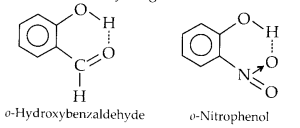
H-bonding is stronger than van der Waals forces.
NCERT Solutions for Class 11 Chemistry Chapter 4, Question 40.
Calculate the bond order of: N2,O2,\({ O }_{ 2 }^{ + }\) and \({ O }_{ 2 }^{ – }\)
Solution.
Bond order of a molecule or an ion is a measure of the strength or stability of the bond. Numerically, it is half of the difference between number of electrons in bonding (Nb) and in anti-bonding (Na) molecular orbitals.Bond order = \(\frac { 1 }{ 2 } ({ N }_{ b }-{ N }_{ a })\)
If B.O. is zero or negative, the bond is highly unstable, i.e. the molecule does not exist. Higher bond order means high bond dissociation energy and greater stability. Greater the bond order, lesser is the bond length.
M.O. configuration of N2 :
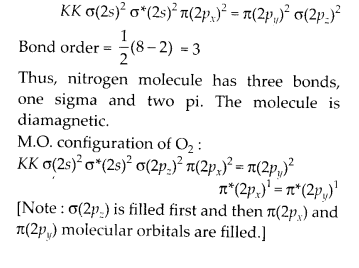
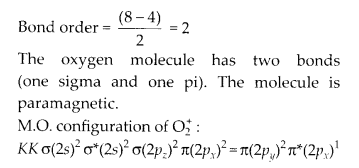
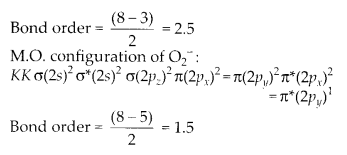
NCERT Class 11 Chemistry
Class 11 Chemistry Chapters | Chemistry Class 11 Chapter 4
Chapterwise NCERT Solutions for Class 11 Chemistry
-
NCERT Solutions For Class 11 Chemistry Chapter 1 Some Basic Concepts of Chemistry
NCERT Solutions For Class 11 Chemistry Chapter 2 Structure of The Atom
NCERT Solutions For Class 11 Chemistry Chapter 3 Classification of Elements and Periodicity in Properties
NCERT Solutions For Class 11 Chemistry Chapter 4 Chemical Bonding and Molecular Structure
NCERT Solutions For Class 11 Chemistry Chapter 5 States of Matter
NCERT Solutions For Class 11 Chemistry Chapter 6 Thermodynamics
NCERT Solutions For Class 11 Chemistry Chapter 7 Equilibrium
NCERT Solutions For Class 11 Chemistry Chapter 8 Redox Reactions
NCERT Solutions For Class 11 Chemistry Chapter 9 Hydrogen
NCERT Solutions For Class 11 Chemistry Chapter 10 The sBlock Elements
NCERT Solutions For Class 11 Chemistry Chapter 11 The pBlock Elements
NCERT Solutions For Class 11 Chemistry Chapter 12 Organic Chemistry: Some Basic Principles and Techniques
NCERT Solutions For Class 11 Chemistry Chapter 13 Hydrocarbons
NCERT Solutions For Class 11 Chemistry Chapter 14 Environmental Chemistry
| NCERT Solutions for Class 12 All Subjects | NCERT Solutions for Class 10 All Subjects |
| NCERT Solutions for Class 11 All Subjects | NCERT Solutions for Class 9 All Subjects |

Post a Comment
इस पेज / वेबसाइट की त्रुटियों / गलतियों को यहाँ दर्ज कीजिये
(Errors/mistakes on this page/website enter here)